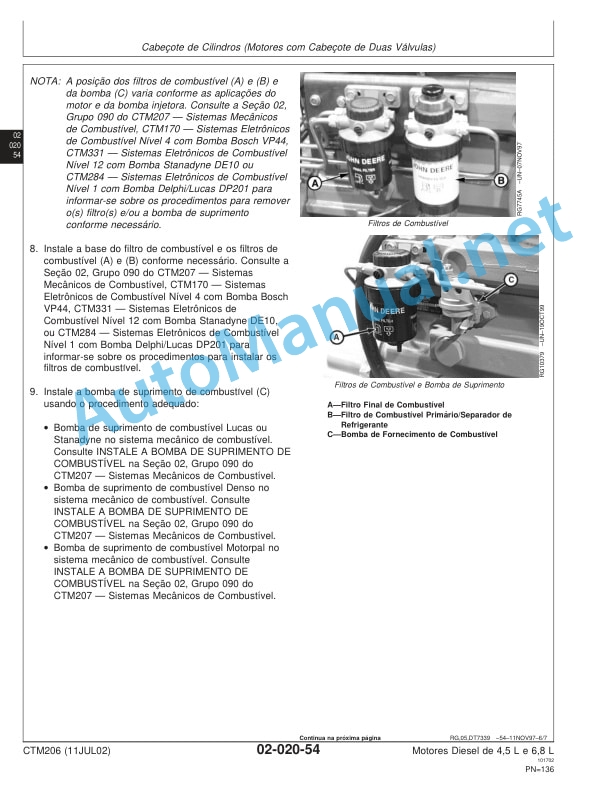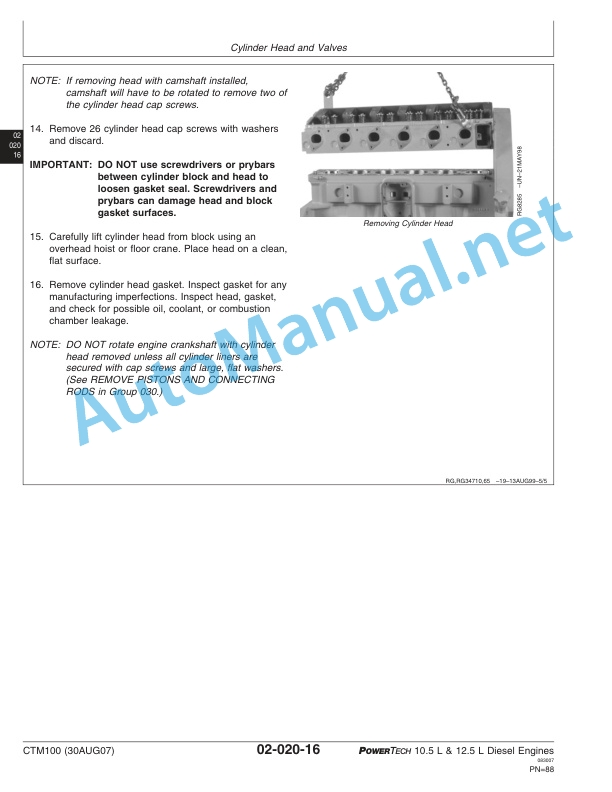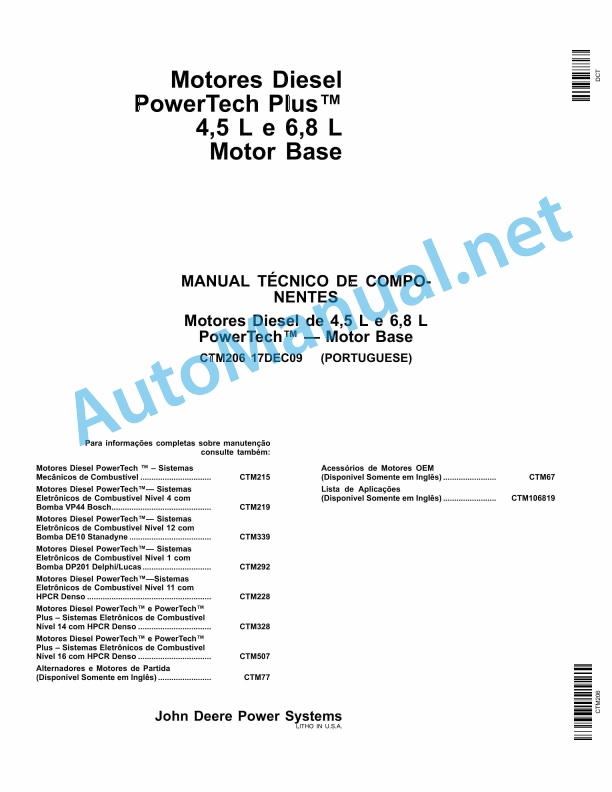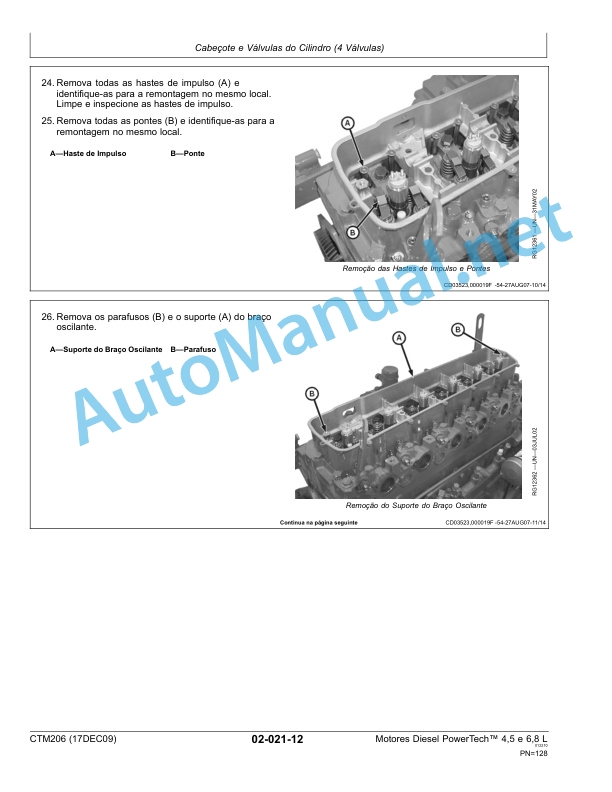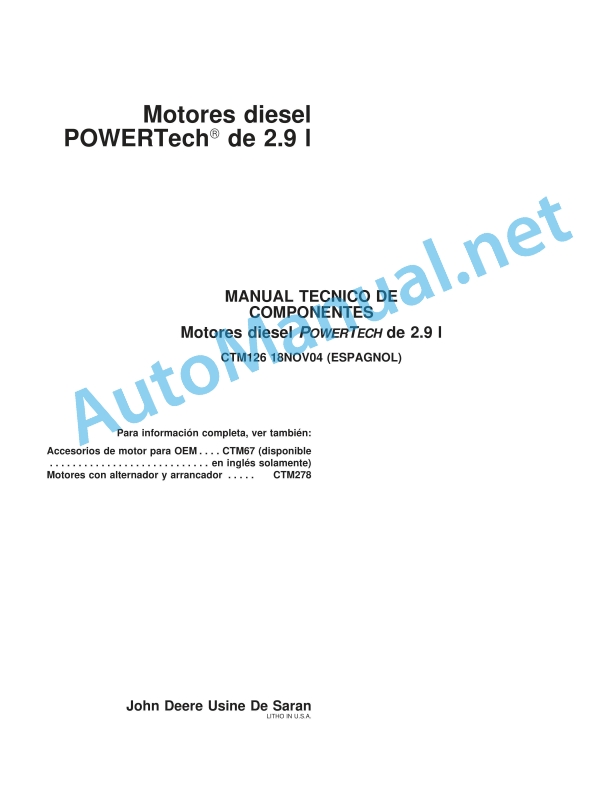Claas Rollant 374 354 Rc Pu 1,85 (763) Baler Operator Manual ES
$50.00
- Model: Rollant 374 354 Rc Pu 1,85 (763) Baler
- Type Of Manual: Operator Manual
- Language: ES
- Format: PDF(s)
- Size: 66.0 MB
File List:
00 0294 426 4.pdf
00 0301 272 1.pdf
00 0294 426 4.pdf:
ROLLANT 354 RotoFeed
ROLLANT 354 RotoCut
1 Regarding this instruction manual
1.1 General data
1.1.1 Validity of the manual
1.1.2 About this user manual
1.1.3 Technical characteristics
2 Security
2.1 General data
2.1.1 General information
2.1.2 Authorized use
2.1.3 Reasonably foreseeable misuse
2.1.4 Highway driving
2.1.5 Symbols applicable to danger indications
2.1.6 Safety regulations
2.1.7 Accident prevention
2.1.8 Waste disposal
2.1.9 Residual risks
2.2 Graphic danger symbols
2.2.1 Description
2.2.2 Location of safety stickers
2.3 Safety equipment
2.3.1 Signal lights
2.3.2 Reflective equipment
2.3.3 Chocks
2.3.4 Holding cable (machine not equipped with brake and usable in France)
2.3.5 Parking brake
2.3.6 Surety
2.3.7 Tailgate lock
2.3.8 Locking the pick-up
2.3.9 Fire extinguisher
3 Machine Description
3.1 Existing models
3.1.1 Name of the machines
3.2 Overview and functions
3.2.1 Left side
3.2.2 Right side
3.2.3 Identification of the rollers
3.3 Work and service positions
3.3.1 General information
3.3.2 Front of the baler
3.4 Identification plate and serial number
3.4.1 Spare parts and technical information
3.4.2 Serial number
3.4.3 Machine identification plate
3.4.4 Rudder identification plate (depending on equipment)
3.4.5 Axle identification plate (depending on equipment)
3.5 General operating principle
3.5.1 Bale pressing cycle
3.6 Control terminal
3.6.1 Control terminal
3.6.2 ISOBUS connection
3.7 Transmission and drive
3.7.1 Power transmission
3.7.2 Main drive
3.7.3 Pick-up drive
3.7.4 Rotor drive (optional)
3.7.5 Drive Chains
3.8 Reception of the harvest
3.8.1 Pick-up
3.8.2 Compactor
3.8.3 Short straw plank (optional)
3.8.4 Reducer roller (option)
3.9 Power set
3.9.1 Rotor
3.9.2 RotoCut cutting device (optional)
3.9.3 Automatic cleaning of the RotoCut blades (option)
3.9.4 Manual rotor reversal (optional)
3.9.5 Hydraulic rotor reversal (optional)
3.10 Pressing system
3.10.1 Pressing chamber and rollers
3.10.2 Pressing cycle
3.11 Tying system
3.11.1 Tying categories and types
3.11.2 Standard tying
3.11.3 Comfort binding
3.11.4 Tying adjustment
3.11.5 Thread compartment (depending on equipment)
3.11.6 Mesh reserve (depending on equipment)
3.11.7 Mesh compartment (depending on equipment)
3.12 Unloading bales
3.12.1 Bale ramp
Use without bale ramp
3.13 Centralized lubrication
3.13.1 Automatic chain lubrication
3.13.2 Centralized manual lubrication (option)
3.13.3 Centralized automatic lubrication (option)
3.14 Brake
3.14.1 General information
3.14.2 Hydraulic braking
3.14.3 Active hydraulic braking
3.14.4 Pneumatic braking
3.15 Hydraulic system
3.15.1 Baler Hydraulic Block
3.15.2 Continuous hydraulic circulation
3.16 Equipment
3.16.1 Ladder (depending on equipment)
3.16.2 Stirrup
3.16.3 Pressure gauge
3.16.4 Electronic module
4 Control and display instruments
4.1 General data
4.1.1 Control terminal
4.1.2 ISOBUS connection
4.2 CLAAS Medium Terminal
4.2.1 Presentation
4.2.2 Screen
4.2.3 Key identification
4.2.4 Home page
4.2.5 Description of the CLAAS Medium Terminal menus
4.3 CLAAS COMMUNICATOR
4.3.1 Presentation
4.3.2 General information
4.3.3 Screen
4.3.4 Key identification
4.3.5 Description of the CLAAS COMMUNICATOR General menu
4.3.6 Description of the CLAAS COMMUNICATOR Use menus
4.3.7 Description of the CLAAS COMMUNICATOR Service menu
4.4 ISOBUS Terminal
4.4.1 Presentation
4.4.2 General information
5 Technical data
5.1 Baler
5.1.1 Dimensions
5.1.2 Weight
5.1.3 Hookup
5.1.4 Cardan shaft
5.1.5 Feeding and pressing
5.1.6 Tying device
5.1.7 Wheels
5.1.8 Hydraulic circuit
5.1.9 Screw tightening torques
5.1.10 Braking
5.1.11 Greasing and lubrication
5.1.12 Sound levels
5.2 Safety devices
5.2.1 Security screw
5.2.2 Torque limiter
5.3 Tractor
5.3.1 Required power
5.3.2 Hooking
5.3.3 PTO
5.3.4 Electrical connections
5.3.5 Hydraulic connections
5.3.6 Hydraulic circuit and oil
5.3.7 Braking
6 Preparation of the machine
6.1 General data
6.1.1 First commissioning
6.1.2 Equipment control
6.2 Cardan shaft
6.2.1 Safety regulations
6.2.2 Cardan shaft adjustment
6.2.3 Adaptation of the cardan shaft length
6.2.4 Placing the cardan shaft
6.3 Trailer support
6.3.1 Recommendations
6.3.2 Types of fixing
6.3.3 Adaptation of the fork hitch / swing bar hitch
6.3.4 Placing the cardan shaft
6.3.5 Holding cable (machine not equipped with brake and usable in France)
6.4 Hydraulic connections
6.4.1 Marking of hydraulic hoses
6.4.2 With CLAAS Medium Terminal
6.4.3 With CLAAS COMMUNICATOR
6.5 Electrical connections
6.5.1 Marking of electrical cables
6.5.2 Lighting
6.5.3 Battery cable (optional)
6.5.4 Power supply to the baler and CLAAS Medium Terminal
6.5.5 Power supply to the baler and CLAAS COMMUNICATOR
6.5.6 Baler power supply with ISOBUS cable
6.6 Brake
6.6.1 Hydraulic brake
6.6.2 Active hydraulic brake
6.6.3 Air brake
6.7 Tying with thread
6.7.1 Preparation
6.7.2 Thread tensioner adjustment
6.7.3 Thread placement
6.7.4 Positioning the side thread stop
6.7.5 Selection of standard twine tying
6.7.6 Selection of tying with comfort thread
6.8 Tying with mesh
6.8.1 Preparation
6.8.2 Mesh placement
6.8.3 Mesh roll brake adjustment
6.8.4 Selection of standard mesh tying
6.8.5 Selection of tying with comfort mesh
6.9 Unloading bales
6.9.1 Assembly of the bale exit ramp
6.9.2 Presetting of the bale exit ramp
6.10 Pressing chamber
6.10.1 Bale start stops
6.10.2 MPS adjustment
6.11 Cutting device
6.11.1 Safety regulations
6.11.2 Control
6.11.3 Placing the blades
6.11.4 Assembly of false blades (optional)
6.11.5 Unused blades and dummy blades
6.12 Machine loading
6.12.1 Baler stowage
6.12.2 Lifting points
6.12.3 Elevation
7 Management
7.1 General data
7.1.1 Baler user
7.1.2 Side doors
7.2 Movements with the baler
7.2.1 Equipment control
7.2.2 Preparations for transportation
7.2.3 Road travel
7.2.4 Arrival at the field
7.2.5 Moving around the field
7.2.6 Parking
7.3 Before each use
7.3.1 Cardan shaft
7.3.2 Reminders
7.3.3 Baler maintenance
7.3.4 Equipment control
7.4 Commissioning in the field
7.4.1 Usage tips
7.4.2 Commissioning of the machine
Machine equipped with CLAAS Medium Terminal
Machine equipped with CLAAS COMMUNICATOR or with an ISOBUS connection
7.5 Pickup
7.5.1 Important
7.5.2 Pick-up wheels
7.5.3 Pick-up height
7.5.4 Compactor
7.6 Tied
7.6.1 Selection of tying with thread or mesh (option)
7.6.2 Setting the number of thread turns
Machine equipped with standard tying
Machine equipped with comfort tying
7.6.3 Adjustment of the number of mesh turns
Machine equipped with standard tying
Machine equipped with comfort tying
7.7 Bale parameters
7.7.1 Bale settings
7.8 CLAAS Medium Terminal
7.8.1 Sound
7.8.2 Selection of tying with thread or mesh (optional)
7.8.3 Resetting the daily counter
7.8.4 Counters Menu
7.8.5 Tying time
7.8.6 Pressing process – tying
Stages of the pressing – tying process
7.8.7 Manual activation of the tying process
7.8.8 Manual delay of the tying process
7.8.9 RotoCut cutting device (optional)
7.8.10 Faults
7.9 CLAAS COMMUNICATOR
7.9.1 Counter Menu
Selection and adjustments of the work
7.9.2 Selection of tying with thread or mesh (option)
7.9.3 Adjustment of usage parameters
Settings
7.9.4 Programmable keys
7.9.5 Pick-up
7.9.6 Pressure recharging of the cylinders from the first bale
7.9.7 RotoCut cutting device
7.9.8 Manual activation of the tying process
Early activation of tying
Tying delay
7.9.9 Pressing process – tying
tied with mesh
tied with thread
Stages of the pressing – tying process
7.9.10 Faults
7.9.11 Baler Diagnostics Submenu
7.10 ISOBUS Terminal
7.10.1 General information
7.11 Unclogging the baler
7.11.1 How to avoid traffic jams?
7.11.2 Safety regulations
7.11.3 Unclogging the pick-up
7.11.4 Unclogging the rotor (baler equipped with CLAAS Medium Terminal)
7.11.5 Unclogging the rotor (baler equipped with CLAAS COMMUNICATOR)
7.12 After use
7.12.1 Reminders
7.12.2 Baler protection
7.12.3 Daily cleaning
7.12.4 Disconnecting the baler
8 Incident and solution
8.1 General data
8.1.1 Sensors
8.2 CLAAS Medium Terminal
8.2.1 General information
8.2.2 Electrical circuit
8.2.3 Bale exit
8.2.4 Tying with thread
8.3 CLAAS COMMUNICATOR
8.3.1 General aspects
8.3.2 Electrical circuit
8.3.3 Bale exit
8.3.4 Tying with mesh
8.3.5 Tying with thread
8.3.6 Thread knife
8.4 Tying system
8.4.1 Origin of problems
8.4.2 Tying with mesh
8.4.3 Tying with thread
8.5 Lubricating oil system
8.5.1 Origin of problems
8.5.2 Troubleshooting
8.5.3 Centralized lubrication
8.6 Other functions
8.6.1 General aspects
8.6.2 General functions
9 Maintenance
9.1 General maintenance instructions
9.1.1 Maintenance and safety tips
9.1.2 Wheels and tires
9.1.3 Brakes
9.1.4 Hydraulic circuit
9.1.5 V-belt
9.1.6 Chains
9.1.7 Pressing and tying device
9.1.8 Hitch
9.1.9 Cardan shaft
9.1.10 Cutting device
9.1.11 Protection devices
9.1.12 Screws and nuts
9.1.13 Lubricants and greasing
9.1.14 Inductive sensors
9.1.15 Welding work
9.1.16 Spare parts
9.2 Maintenance tables
9.2.1 Maintenance operations before harvest
9.2.2 Maintenance operations after the first 10 hours of service
9.2.3 Maintenance operations after the first 50 hours of service
9.2.4 Maintenance operations every 8 hours of service or every day
9.2.5 Maintenance operations every 50 hours of service
9.2.6 Maintenance operations every 100 hours of service
9.2.7 Maintenance operations every 250 hours of service
9.2.8 Annual maintenance operations or every 500 hours of service
9.2.9 Maintenance operations if necessary
9.3 Lubricant tables
9.3.1 Lubricants
9.4 Greasing scheme
9.4.1 Greasing
9.4.2 Grease points – 8 h
9.4.3 Greasing points – 50 h
9.4.4 Grease points – 100 h
9.4.5 Grease points – 250 h
9.5 Gear maintenance work
9.5.1 540 rpm drive box
9.5.2 Drive box 1,000 rpm
9.5.3 Cardan shaft security screw
Replacing the screw
9.6 Axle and wheel maintenance operations
9.6.1 Tire check
9.6.2 Wheel tightening check
9.6.3 Replacing the wheels
9.6.4 Wheel hub
9.7 Brake maintenance operations
9.7.1 Hydraulic and active hydraulic braking
9.7.2 Pneumatic braking
9.7.3 Replacing the brake linings
9.8 Hitch device maintenance operations
9.8.1 Fixing the hitch hole and rudder
9.9 Hydraulic system maintenance operations
9.9.1 Filter
9.10 Pick-up maintenance operations
9.10.1 Pick-up drive chains
9.10.2 Pick-up security screw
9.10.3 Pick-up tensioner
9.11 Maintenance work on the power supply unit
9.11.1 Rotor drive spring
9.11.2 Adjusting the height of the blades (RotoCut Machines)
9.11.3 Rotor reversing device security screw (optional)
9.12 Pressing chamber maintenance operations
9.12.1 MPS springs (oscillating segment)
9.12.2 Roller drive springs
9.12.3 Cleaning the roller
9.13 Tying maintenance operations
9.13.1 Tying with thread
9.13.2 Tying with mesh
9.14 Bale unloading maintenance operations
9.14.1 Bale ramp
9.15 Maintenance operations of the centralized lubrication system
9.15.1 Chain lubrication
9.15.2 Centralized manual lubrication of bearings (option)
9.15.3 Automatic centralized bearing lubrication (option)
9.16 Bodywork maintenance operations
9.16.1 Fire extinguisher (optional)
9.17 Hibernation
9.17.1 General information
9.17.2 Cleaning
9.17.3 Greasing
9.17.4 Maintenance
9.17.5 Storage
10 Decommissioning and waste disposal
10.1 General data
10.1.1 End of operational life and waste disposal
11 EU declaration of conformity
11.1 General data
11.1.1 Declaration of conformity for CE
00 0301 272 1.pdf:
ROLLANT 374 RotoFeedROLLANT 374 RotoCutROLLANT 375 RotoCut
1 Regarding this instruction manual
1.1 General information
1.1.1 Application of this user manual
1.1.2 About this user manual
1.1.3 Symbols and indications
1.1.4 Technical characteristics
2 Security
2.1 General information
2.1.1 General information
2.1.2 Authorized use
2.1.3 Reasonably foreseeable misuse
2.1.4 Highway driving
2.1.5 Symbols applicable to danger indications
2.1.6 Safety regulations
2.1.7 Accident prevention
2.1.8 Waste disposal
2.1.9 Residual risks
2.2 Graphic danger symbols
2.2.1 Description
2.2.2 Location of safety stickers
2.3 Safety equipment
2.3.1 Signal lights
2.3.2 Reflective equipment
2.3.3 Chocks
2.3.4 Holding cable (machine not equipped with brake and usable in France)
2.3.5 Parking brake
2.3.6 Surety
2.3.7 Tailgate lock
2.3.8 Locking the pick-up
2.3.9 Fire extinguisher
3 Machine Description
3.1 Existing models
3.1.1 Name of the machines
3.2 Overview and functions
3.2.1 Left side
3.2.2 Right side
3.2.3 Identification of the rollers
3.3 Work and service positions
3.3.1 General information
3.3.2 Front of the baler
3.4 Identification plate and serial number
3.4.1 Spare parts and technical information
3.4.2 Position of the nameplates
3.4.3 Machine nameplate
3.4.4 Rudder nameplate
3.5 General operating principle
3.5.1 Bale pressing cycle
3.6 Control terminal
3.6.1 Control terminal
3.6.2 ISOBUS connection
3.6.3 EASY on board
3.7 Transmission and drive
3.7.1 Power transmission
3.7.2 Main drive
3.7.3 Pick-up drive
3.7.4 Rotor drive
3.7.5 Drive Chains
3.8 Harvest harvest
3.8.1 Pick-up
3.8.2 Compactor
3.8.3 Short straw plank (optional)
3.8.4 Reducer roller (option)
3.9 Power supply unit
3.9.1 Rotor
3.9.2 Rotor frame with swing floor (option)
3.9.3 RotoCut cutting device (option)
3.9.4 Automatic cleaning of the RotoCut blades (option)
3.9.5 Manual rotor reversal*
3.10 Pressing system
3.10.1 Pressing chamber and rollers
3.10.2 Pressing cycle
3.11 Tying system
3.11.1 Tying categories and types
3.11.2 Standard tying
3.11.3 Comfort binding
3.11.4 Tying adjustment
3.11.5 Thread box (depending on equipment)
3.11.6 Mesh reserve (depending on equipment)
3.11.7 Mesh compartment (depending on equipment)
3.12 Unloading bales
3.12.1 Bale unloading ramp
Use without bale unloading ramp
3.13 Lubrication system
3.13.1 Automatic chain lubrication
3.14 Greasing system
3.14.1 General information
3.14.2 Manual centralized lubrication (option)
3.14.3 Centralized automatic lubrication (option)
3.14.4 Electric centralized automatic lubrication (option)
3.15 Brake
3.15.1 General information
3.15.2 Hydraulic braking
3.15.3 Active hydraulic braking
3.15.4 Pneumatic braking
3.16 Hydraulic system
3.16.1 Baler Hydraulic Block
3.16.2 Continuous hydraulic circulation
3.17 Equipment
3.17.1 Ladder (Depending on equipment)
3.17.2 Stirrup
3.17.3 Pressure gauge
3.17.4 Electronic module
4 Control and display instruments
4.1 OPERATOR
4.1.1 Presentation
4.1.2 Description of the OPERATOR menus
4.2 COMMUNICATOR II
4.2.1 Presentation
4.2.2 Description of the menus Using the COMMUNICATOR
4.3 ISOBUS Terminal
4.3.1 General information
4.4 EASY on board
4.4.1 Presentation
4.4.2 General information
5 Technical data
5.1 Baler
5.1.1 Dimensions
5.1.2 Weight
5.1.3 Hookup
5.1.4 Cardan shaft
5.1.5 Feeding and pressing
5.1.6 Tying device
5.1.7 Wheels
5.1.8 Hydraulic circuit
5.1.9 Screw tightening torques
5.1.10 Braking
5.1.11 Greasing and lubrication
5.1.12 Sound levels
5.2 Safety devices
5.2.1 Security screw
5.2.2 Torque limiter
5.3 Tractor
5.3.1 Required power
5.3.2 Hooking
5.3.3 PTO
5.3.4 Electrical connections
5.3.5 Hydraulic connections
5.3.6 Hydraulic circuit and oil
5.3.7 Braking
6 Preparation of the machine
6.1 General information
6.1.1 First commissioning
6.1.2 Equipment control
6.2 Cardan shaft
6.2.1 Safety regulations
6.2.2 Cardan shaft adjustment
6.2.3 Adaptation of the cardan shaft length
6.2.4 Transformation kit, 8 grooves*
6.2.5 Placing the cardan shaft
6.3 Trailer support
6.3.1 Recommendations
6.3.2 Types of fixing
6.3.3 Adaptation of the fork hitch / swing bar hitch
6.3.4 Placing the cardan shaft
6.3.5 Holding cable (machine not equipped with brake and usable in France)
6.4 Hydraulic connections
6.4.1 With OPERATOR*
6.4.2 With COMMUNICATOR*
6.5 Electrical connections
6.5.1 Marking of electrical cables
6.5.2 Lighting
6.5.3 Battery cable (optional)
6.5.4 Power supply to the baler and OPERATOR*
6.5.5 Power supply to the baler and COMMUNICATOR*
6.5.6 Baler power supply with ISOBUS cable
6.5.7 Baler power supply with
6.6 Brake
6.6.1 Hydraulic brake
6.6.2 Active hydraulic brake
6.6.3 Air brake
6.7 Tying with thread
6.7.1 Yarn quality
6.7.2 Preparation
6.7.3 Thread tensioner adjustment
6.7.4 Thread placement
6.7.5 Positioning the side thread stop
6.7.6 Selection of tying with standard twine*
6.7.7 Selection of tying with comfort thread*
6.8 Tying with mesh
6.8.1 Preparation
6.8.2 Mesh placement
6.8.3 Mesh roll brake adjustment
6.8.4 Selection of tying with standard mesh*
6.8.5 Selection of tying with comfort mesh*
6.9 Unloading bales
6.9.1 Assembly of the bale unloading ramp
6.9.2 Presetting of the bale unloading ramp
6.10 Pressing chamber
6.10.1 Bale start stops
6.10.2 MPS Regulation
6.11 Cutting device
6.11.1 Safety regulations
6.11.2 Control
6.11.3 Placing the blades
RotoCut baler with fixed rotor bottom*
RotoCut baler with folding rotor bottom*
6.11.4 Placing the false blades*
6.11.5 Unused blades and dummy blades
6.12 Load the machine
6.12.1 Baler stowage
6.12.2 Lifting points
6.12.3 Elevation
7 Management
7.1 General information
7.1.1 Baler user
7.1.2 Side doors
7.2 Movements with the baler
7.2.1 Equipment control
7.2.2 Preparations for transportation
7.2.3 Road travel
7.2.4 Arrival at the field
7.2.5 Moving around the field
7.2.6 Parking
7.3 Before each use
7.3.1 Cardan shaft
7.3.2 Reminders
7.3.3 Baler maintenance
7.3.4 Equipment control
7.4 Commissioning in the field
7.4.1 Usage tips
7.4.2 Commissioning of the machine
Machine equipped with OPERATOR*
pressing pressure
cardan shaft
cutting system
Machine equipped with COMMUNICATOR* or with an ISOBUS* connection
Continuous hydraulic circulation
pressing pressure
cardan shaft
cutting system
7.5 Pick-up
7.5.1 Important
7.5.2 Pick-up wheels
7.5.3 Pick-up height
7.5.4 Compactor
7.6 Tied
7.6.1 Selection of tying with thread or mesh (optional)
7.6.2 Setting the number of thread turns
Machine equipped with standard tying
Reminder
Adjustment system
Tying drive strap positions
Setting the number of thread turns
Tying drive pulley positions
Pulley position change
Machine equipped with comfort tying
Reminder
Adjustment
7.6.3 Adjustment of the number of mesh turns
Machine equipped with standard tying
Reminder
Adjustment system
Eccentric stop position
Adjustment of the number of turns
Machine equipped with comfort tying
Reminder
Adjustment
7.6.4 Changing the mesh roll
Standard tying*
Comfort lacing*
7.7 Bale parameters
7.7.1 Bale settings
7.8 OPERATOR
7.8.1 Counters Menu
7.8.2 Setting bale parameters
Tying time
Setting tying times
Tying type selection
7.8.3 Pressing-tying process
7.8.4 Manual activation of the tying process
7.8.5 Manual delay of the tying process
7.8.6 RotoCut with fixed rotor bottom*
7.8.7 RotoCut with folding rotor bottom*
7.8.8 Faults
7.9 COMMUNICATOR II
7.9.1 Counters Menu
Resetting the maintenance indicator
Maintenance indicator
7.9.2 Choosing the task
7.9.3 Task name
7.9.4 Print customer or task data
7.9.5 Settings Menu
Setting usage parameters
Settings
Tying type selection
Number of loops of mesh or thread*
Adjustment
Tying time
Adjustment
Automatic blade cleaning
Adjustment
Automatic pressure recharge
Adjustment
Automatic tailgate opening
Adjustment
Interval between 2 lubrications (electric centralized lubrication*)
Adjustment
7.9.6 Pick-up
7.9.7 Pressure recharge
7.9.8 Opening the tailgate
Manual tailgate opening/closing
Manual tailgate opening
Manual tailgate closing
Attention
Programmable keys
7.9.9 RotoCut* cutting device
7.9.10 Folding rotor bottom*
7.9.11 Manual activation of the tying process
Early activation of tying
Tying delay
Programmable keys
7.9.12 Pressing-tying process
Stages of the pressing-tying process
Stages of tying with comfort mesh
Stages of tying with comfort thread
7.9.13 Electric centralized lubrication*
7.9.14 Faults
7.9.15 Functions assignable to programmable keys
7.10 ISOBUS Terminal
7.10.1 General information
7.11 EASY on board
7.11.1 General information
7.12 Unclogging the baler
7.12.1 How to avoid traffic jams?
7.12.2 Safety regulations
7.12.3 Unjamming the pick-up
7.12.4 Unclogging the rotor (baler equipped with OPERATOR)
7.12.5 Unclogging the rotor (baler equipped with COMMUNICATOR)
7.13 After use
7.13.1 Reminders
7.13.2 Securing the baler
7.13.3 Daily cleaning
7.13.4 Disconnecting the baler
8 Incident and solution
8.1 General information
8.1.1 Sensors
8.2 OPERATOR
8.2.1 Unloading the bale
8.2.2 Tying with thread*
8.3 COMMUNICATOR II
8.3.1 General information
8.3.2 Unloading the bale
8.3.3 Tying with mesh
8.3.4 Tying with thread
8.3.5 Cutting depth
8.4 Tying system
8.4.1 Origin of problems
8.4.2 Tying with mesh
8.4.3 Tying with thread
8.5 Lubrication system
8.5.1 Origin of problems
8.5.2 Troubleshooting
8.6 Greasing system
8.6.1 Centralized lubrication
8.7 Other functions
8.7.1 General information
8.7.2 General functions
9 Maintenance
9.1 General maintenance instructions
9.1.1 Maintenance and safety tips
9.1.2 Wheels and tires
9.1.3 Brakes
9.1.4 Hydraulic circuit
9.1.5 V-belt
9.1.6 Chains
9.1.7 Pressing and tying device
9.1.8 Hitch
9.1.9 Cardan shaft
9.1.10 Cutting device
9.1.11 Protection devices
9.1.12 Screws and nuts
9.1.13 Lubricants and greasing
9.1.14 Inductive sensors
9.1.15 Welding work
9.1.16 Spare parts
9.2 Maintenance tables
9.2.1 Maintenance operations before harvest
9.2.2 Maintenance operations after the first 10 hours of service
9.2.3 Maintenance operations after the first 50 hours of service
9.2.4 Maintenance operations every 8 hours of service or every day
9.2.5 Maintenance operations every 50 hours of service
9.2.6 Maintenance operations every 100 hours of service
9.2.7 Maintenance operations every 250 hours of service
9.2.8 Annual maintenance operations or every 500 hours of service
9.2.9 Maintenance operations if necessary
9.3 Lubricant tables
9.3.1 Lubricants
9.4 Greasing scheme
9.4.1 Greasing
9.4.2 Grease points – 8 h
9.4.3 Greasing points – 50 h
9.4.4 Grease points – 100 h
9.4.5 Grease points – 250 h
9.5 Gear maintenance operations
9.5.1 Drive box 540 rpm
9.5.2 Drive box 1,000 rpm
9.5.3 Cardan shaft security screw
Replacing the screw
9.6 Axle and wheel maintenance operations
9.6.1 Tire check
9.6.2 Wheel tightening check
9.6.3 Replacing the wheels
9.6.4 Wheel hub
9.7 Brake maintenance operations
9.7.1 Hydraulic and active hydraulic braking
9.7.2 Pneumatic braking
9.7.3 Replacing the brake linings
9.8 Hitch device maintenance operations
9.8.1 Fixing the hitch hole and rudder
9.9 Hydraulic system maintenance operations
9.9.1 Filter
9.10 Pick-up maintenance operations
9.10.1 Pick-up drive chains
9.10.2 Pick-up security screw
9.10.3 Pick-up tensioner
9.11 Maintenance operations on the power supply unit
9.11.1 Rotor drive spring
9.11.2 Adjusting the height of the blades (RotoCut Machines)
9.12 Pressing chamber maintenance operations
9.12.1 MPS springs (oscillating segment)
9.12.2 Roller drive springs
9.12.3 Cleaning the roller
9.13 Tying maintenance operations
9.13.1 Tying with thread
9.13.2 Tying with mesh
9.14 Bale unloading maintenance operations
9.14.1 Bale unloading ramp
9.15 Lubrication system maintenance operations
9.15.1 Chain lubrication
9.16 Maintenance operations of the lubrication system
9.16.1 Manual lubrication
9.16.2 Manual centralized lubrication of the bearings (optional)
9.16.3 Centralized automatic lubrication of bearings (optional)
9.16.4 Electric automatic centralized lubrication (optional)
9.17 Bodywork maintenance operations
9.17.1 Fire extinguisher (optional)
9.18 Hibernation
9.18.1 General information
9.18.2 Cleaning
9.18.3 Greasing
9.18.4 Maintenance
9.18.5 Storage
10 Decommissioning and waste disposal
10.1 General information
10.1.1 Decommissioning and waste disposal
11 EC declaration of conformity
11.1 General information
11.1.1 Declaration of conformity for CE
John Deere Repair Technical Manual PDF
John Deere PowerTech M 10.5 L and 12.5 L Diesel Engines COMPONENT TECHNICAL MANUAL CTM100 10MAY11
John Deere Repair Technical Manual PDF
John Deere Repair Technical Manual PDF
John Deere Repair Technical Manual PDF
John Deere Repair Technical Manual PDF
John Deere Repair Technical Manual PDF
John Deere Repair Technical Manual PDF
John Deere Repair Technical Manual PDF
John Deere DF Series 150 and 250 Transmissions (ANALOG) Component Technical Manual CTM147 05JUN98
John Deere Repair Technical Manual PDF
John Deere Diesel Engines POWERTECH 2.9 L Component Technical Manual CTM126 Spanish









